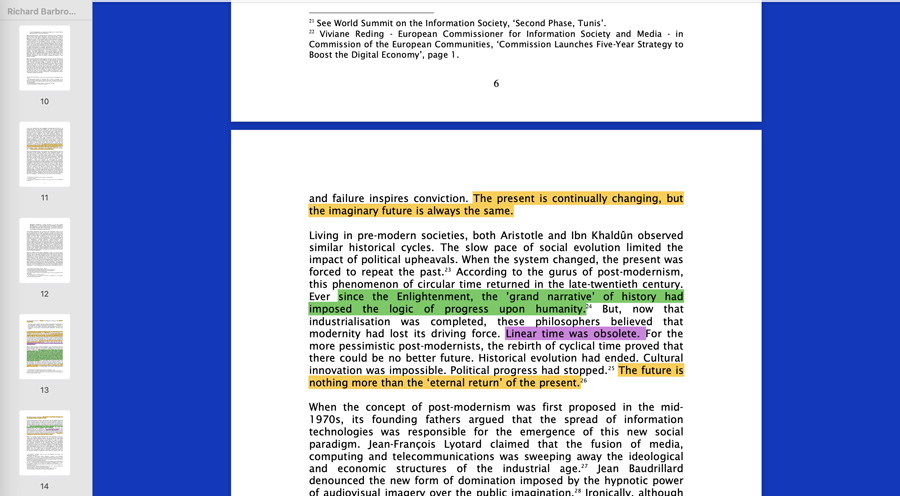Future Design Reader: Difference between revisions
m (→_references) |
m (→_references) |
||
| Line 29: | Line 29: | ||
★ ItinerAnts (2024). (https://www.urbex4youth.org/toolkit) A modular adventure game that encourages you to explore, imagine and propose transformations for the city you live in. Developed as part of UrbEx project.<br> | ★ ItinerAnts (2024). (https://www.urbex4youth.org/toolkit) A modular adventure game that encourages you to explore, imagine and propose transformations for the city you live in. Developed as part of UrbEx project.<br> | ||
★ Lewis, D. (1973). Counterfactuals. Harvard University Press.<br> | ★ Lewis, D. (1973). Counterfactuals. Harvard University Press.<br> | ||
★ Moreno Ger, Pablo & Torrente, Javier & Hsieh, Yichuan & Lester, William. (2012). Usability Testing for Serious Games: Making Informed Design Decisions with User Data. Advances in Human-Computer Interaction. 2012. 10.1155/2012/369637. <br> | |||
★ Nate Silver (2012). The Signal and the Noise : Why So Many Predictions Fail-- But Some Don’t. New York: Penguin Books. <br> | ★ Nate Silver (2012). The Signal and the Noise : Why So Many Predictions Fail-- But Some Don’t. New York: Penguin Books. <br> | ||
★ Nobody Wants This. (2024). [TV Series] Netflix.<br> | ★ Nobody Wants This. (2024). [TV Series] Netflix.<br> | ||
Revision as of 11:48, 22 October 2024
_work-in-progress
// created for my CYENS Art Residency 2024
_intro
The references and inspirations that inform this research are connected to the worldwide topics of history, society, culture, technology, the contemporary world, current global and local challenges, and the future. With this exploration, I am interested in the friction between different reads, movies, games, and any artworks that give a take on how we imagine our future(s) and how much we realise our role in its(their) shaping.
This reader was created during my CYENS Art Residency 2024 in Lefkosia, Cyprus (September-December 2024).
_references
★ Achilleos, A. (2023-2024). AI Colonialism Board Game. A collaborative artist game (a board game with an artistic intent), that aims to raise awareness of AI’s societal impact and power dynamics on a local, Cypriot level and thus contribute to AI literacy amongst the inhabitants of Cyprus.
★ Barbrook, R. (2007). Imaginary futures : from thinking machines to the global village. London: Pluto.
★ Chun, Wendy Hui Kyong: Queerying Homophily. In: Clemens Apprich, Wendy Hui Kyong Chun, Florian Cramer u.a. (Hg.): Pattern Discrimination. Lüneburg: meson press 2018, S. 59–97. DOI: https://doi.org/10.25969/mediarep/12350.
★ Commonspoly (2020). (https://commonspoly.cc/) Commonspoly is a non-profit, open source board game that encourages a culture of cooperation and questions the violent model of neoliberal privatisation.
★ Conversations with Edouard Glissant (2010). Documentary
★ Dunne, A. and Raby, F. (2013). Speculative Everything : Design, Fiction, and Social Dreaming. Erscheinungsort Nicht Ermittelbar: Mit Press.
★ Extrapolations. (2023). Apple TV+.
★ Господинов, Г. (2024). Градинарят и смъртта. Пловдив. Жанет-45
★ Graeber, D. and Wengrow, D. (2021). The dawn of everything : a new history of humanity. London: Penguin Books.
★ ItinerAnts (2024). (https://www.urbex4youth.org/toolkit) A modular adventure game that encourages you to explore, imagine and propose transformations for the city you live in. Developed as part of UrbEx project.
★ Lewis, D. (1973). Counterfactuals. Harvard University Press.
★ Moreno Ger, Pablo & Torrente, Javier & Hsieh, Yichuan & Lester, William. (2012). Usability Testing for Serious Games: Making Informed Design Decisions with User Data. Advances in Human-Computer Interaction. 2012. 10.1155/2012/369637.
★ Nate Silver (2012). The Signal and the Noise : Why So Many Predictions Fail-- But Some Don’t. New York: Penguin Books.
★ Nobody Wants This. (2024). [TV Series] Netflix.
★ O’Brien R. and Forbes A. Speculative Futuring: Learners as Experts on Their Own Futures. In: Journal of Futures Studies, December 2021,Vol. 26(2) 19–36. DOI: 10.6531/JFS.202112_26(2).0002
★ Pierson, P. (2004). Politics in time : history, institutions, and social analysis. Princeton: Princeton University Press. // path dependency, how historical decisions influence and constrain future outcomes
★ Sohie, C. (2023). Speculative Futures: Design for Change. In: Hilal, S., Bedir, M., Ramsgaard Thomsen, M., Tamke, M. (eds) Design for Partnerships for Change. UIA 2023. Sustainable Development Goals Series. Springer, Cham. https://doi.org/10.1007/978-3-031-36993-3_19
_notes
☁ _reflections
_For Glissant, "we are in the same family when we share the same reactions and intuitions of the world (...) when we have the same manners". The roots can be found through poetry or knowledge. It is the common knowledge we accept from our parents and teachers (of any form) when we grow up. From the people we know and the events we experience. Thus, our predictions are "educated guesses" with the support of what we know, have seen, have read, have heard and experienced. When we look at the future, "we see the horizon through our imagination". The future we can create is the one we can imagine.
_Wendy Hui Kyong Chun's collected data and grouped subjects with the help of similarity. Similarity breeds connection. She argues, "Homophily is the mechanism by which individuals “stick” together, and “wes” emerge". Predictions can be made thanks to the trained programmes which work with the collected data. However, "predictions can be “self-canceling” as well as self-fulfilling", she quotes Nate Silver. Thus, there are multiple possible futures. Everyone's imagination brings one future and we collectively shape our collective future.
_Similarity and homophily are a strong core of the way people live, interact, and therefore - shape the future.
❞ _quotes
❞ In the prophecies of artificial intelligence and the information society, ideology is used to warp time. The importance of a new technology is not for what it can do in the here and now, but for what more advanced models might be able to do one day. The present is understood as the future in embryo – and the future illuminates the potential of the present. (…) The present already contains the future and this future explains the present. (...) Contemporary reality is the beta version of a science fiction dream: the imaginary future. [p.6] (...) The present is continually changing, but the imaginary future is always the same. [p.7] Barbrook, R. (2007)
_glossary
tba
